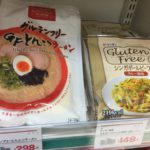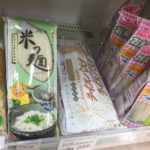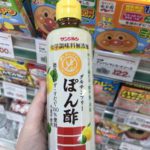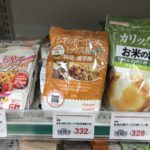グルテンフリー: gluten-free
I am personally not gluten-free, so I don’t really know all the “ins-and-outs,” but I can give a little help in finding some gluten-free and wheat-free items in Okinawa.
This can be difficult because I don’t think gluten-free is really a thing in Japan. But luckily, in SanA there is the “special dietary” section, and you can find a few items here… some are even labelled in English (!!). This is in the same section as the soy-free section I posted about awhile back. In some other stores, the items might be spread around and you have to look a little harder for the key words and ingredients.
As for items like shoyu and miso, wheat is often used so you have to look carefully and clearly for the no-wheat label, and check the ingredients. Luckily wheat is one of the 7 REQUIRED food allergy labels in Japan, so at least it is easy to identify if there is wheat or not in the ingredients! On the back of the product there is an allergy section, and if the product contains wheat it will be highlighted clearly. Gluten-free miso and shoyu are not usually in the special dietary section, so you may need to check the regular shoyu and miso aisles.
Rice flour and rice noodles (as well as some other types like konnyaku noodles, aka shirataki) are easy to find in most supermarkets, so gluten-free living in Okinawa should not be too much of a challenge.
gluten ingredients in Japanese:
小麦: wheat
大麦: barley
ライ麦: rye
バルガー: bulgar
蕎麦: buckwheat
麦芽: malt
水飴: starch syrup
phrases to look for:
グルテン入ってない: no gluten
小麦不使用: no wheat (or more literally wheat non-use)
___不使用: no ______
The “okay” ingredients:
米: rice
大豆: soybean
こんにゃく: konnyaku (konjac)
Hopefully this gives a start as to what to look for in the grocery stores if you are looking for a gluten-free diet or a diet with wheat allergies, but this is NOT a comprehensive guide. If you would like to more know words to look for on packages or know of any I missed, just add a comment and I will update the post with more information. Depending on the degree of the gluten or wheat allergy, you may want to consider getting one of the translated restaurant allergy cards for when you would like to eat locally, especially since gluten-free and gluten allergies are relatively unknown to most Japanese.



